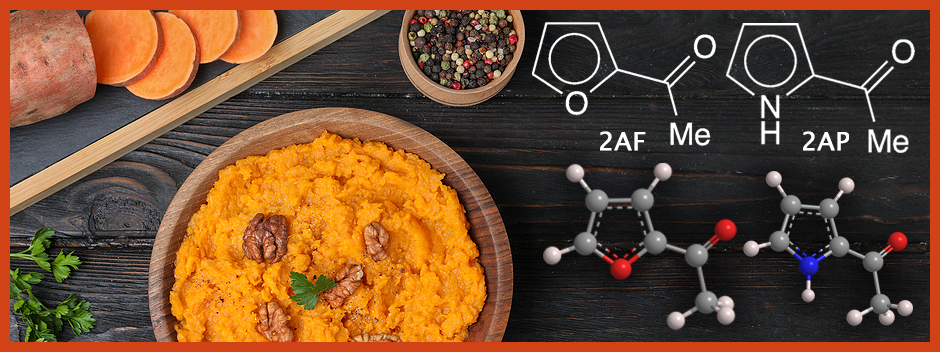What molecules are we?

Happy Thanksgiving! If you are like many of us, sweet potatoes (aka yams) are one of the highlights of your Turkey Day meal. The aroma of a casserole baking in the oven adds to that comfort-food feeling.
A chemist would naturally ask, “Why do roasting or baking sweet potatoes smell so good?” Ola Lasekan* and Li Shing Teoh at University Putra Malaysia (Serdang), identified 29 aroma compounds in roasting white yam (Dioscorea rotundata)1. Among them, the two that had the highest odor activity factors were 2-acetylfuran (2AF, aka 2-furyl methyl ketone) and 2-acetylpyrrole (2AP, aka 2-pyrrolyl methyl ketone).
According to the authors, 2AF “elicited an almond-like note” whereas 2AP had “a popcorn-like note”. The aromas emitted by the other components, mostly furans, pyrroles, and pyrazines, were given labels such as “toasty”, “caramel”, “chamomile flower–like”, and “smoky”.
The focus of this study was to identify the aroma compounds that contribute to the potatoes’ antioxidant properties. Using an established test based on substances’ ability to inhibit the oxidation of hexanal, the authors found that the pyrrole-containing aroma components were substantially superior antioxidants to the furans and especially the pyrazines.
A glance at the hazard information tables shown here might give you pause. 2AF in particular looks as if it might kill you as you’re enjoying the holiday. But rest assured that these, like many other odorous substances, are detectable in air at very low concentrations.
So, this Thanksgiving Day, while you’re watching the virtual Macy’s parade and NFL football games, take satisfaction that some of the food aromas you’re inhaling add to your antioxidant supply.
1. Full disclosure: Dioscorea spp. are “true yams”, as opposed to the orange-colored sweet potatoes (Convolvulaceae spp.) that some Americans call yams. The baking and roasting aromas of both yam genera contain 2AF and 2AP.
2-Acetylfuran hazard information
| Hazard class* | Hazard statement | |
|---|---|---|
| Flammable liquids, category 4 | H227—Combustible liquid | |
| Acute toxicity, oral, category 2 | H300—Fatal if swallowed | |
| Acute toxicity, dermal , category 3 | H311—Toxic in contact with skin | |
| Serious eye damage/eye irritation, category 1 | H318—Causes serious eye damage | |
| Acute toxicity, inhalation, category 2 | H330—Fatal if inhaled | |
*Globally Harmonized System of Classification and Labeling of Chemicals.
Explanation of pictograms.
2-Acetylpyrrole hazard information
| Hazard class* | Hazard statement | |
|---|---|---|
| Acute toxicity, oral, category 4 | H302—Harmful if swallowed | |
| Skin corrosion/irritation, category 2 | H315—Causes skin irritation | |
| Specific target organ toxicity, single exposure, respiratory tract irritation, category 3 | H335—May cause respiratory irritation | |
*Globally Harmonized System of Classification and Labeling of Chemicals.
Explanation of pictograms.
2-Acetylfuran fast facts
| CAS Reg. No. | 1192-62-7 |
| SciFinder nomenclature | Ethanone, 1-(2-furanyl)- |
| Empirical formula | C6H6O2 |
| Molar mass | 110.11 g/mol |
| Appearance | Yellow to brown liquid or solid |
| Melting range | 26–33 ºC |
| Boiling point | 175 ºC |
| Water solubility | Very slight |
2-Acetylpyrrole fast facts
| CAS Reg. No. | 1072-83-9 |
| SciFinder nomenclature | Ethanone, 1-(1H-pyrrol-2-yl)- |
| Empirical formula | C6H7NO |
| Molar mass | 109.13 g/mol |
| Appearance | White to beige crystals or powder |
| Melting point | 90.0–90.5 ºC |
| Water solubility | 274 g/L |

Learn more about this molecule from CAS, the most authoritative and comprehensive source for chemical information.
Molecule of the Week needs your suggestions!
If your favorite molecule is not in our archive, please send us a message. The molecule can be notable for its current or historical importance or for any quirky reason. Thank you!
Stay Ahead of the Chemistry Curve
Learn how ACS can help you stay ahead in the world of chemistry.

